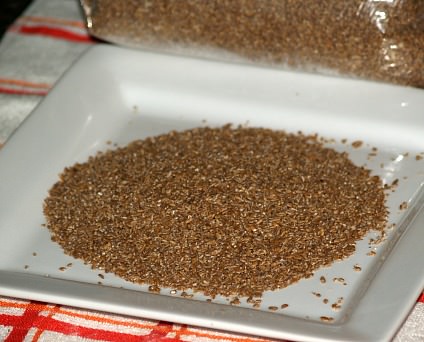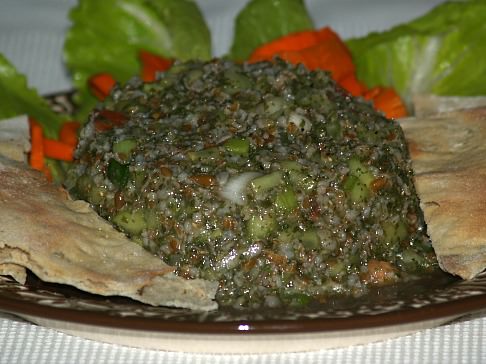- Painless Cooking
- Grains
- Bulgur
What is Bulgur?
What is bulgur? As a grain created from a variety of wheat species, bulgur is a staple in the Middle Eastern diet, as well as in Greece, Armenia, Turkey and Bulgaria. Processing of bulgur consists of cleaning, parboiling, drying and then grounding it into fine particles. In addition to being versatile and healthy, bulgur can spend a long time on a shelf without deteriorating.
Knowing exactly what is bulgur means you will not mistake it for cracked wheat; bulgur has been pre-cooked, whereas cracked wheat has not. It possesses a tasty, nutty flavor and can be consumed after a short period of cooking or after it has been soaked in broth or water.
Benefits of Grain
Grains like bulgur contain minerals and vitamins which our body needs to continue functioning properly. In comparison to rice, bulgur contains more protein, fiber and a reduced glycemic index. Bulgur also imparts a good amount of dietary fiber, potassium and iron and is low in fat.
Bulgur can also be considered a substitute for potatoes since it supplies the body with phytonutrients. In addition, it also provides manganese, a mineral necessary for good bone health that is found in healthy amounts in grains. What is bulgur or any other whole wheat grain without the positive benefits of fiber?
How to Cook Bulgur
As one of the easiest grains to cook, bulgur can give you a last minute boost to a meal that needs another quick side dish. If you already have bulgur that has been grinded, just add boiling water to the bulgur and wait for around five minutes until the wheat has fully absorbed the water. Bulgur can also be prepared to eat by using unheated water and letting it sit for about one hour.
However, remember that bulgur wheat has the ability to double its size after soaking in water, so one cup of bulgur wheat will yield three cups of edible wheat. One issue people may encounter when cooking with grains is this capacity to expand when exposed to moisture, which sometimes results in having leftover grain.
Bulgur Recipes
Besides being versatile enough to act as a substitute for meat in
vegetarian recipes, bulgur can also be used to make bread, or used as
stuffing for eggplant and cabbage. It also works well as a healthy meat
extender, whether used in meatloaf or stews.
BULGUR WHEAT PILAF RECIPE
- 2 c. bulgur wheat
- 3 1/2 c. chicken or beef bouillon
- 1 c. chopped celery and leaves
- 3/4 c. butter
- 1 c. chopped green onions
- 1/2 c. chopped parsley
- 1 tbsp. lemon pepper
- Salt
In a skillet, sauté the onions, parsley and celery in 1/2 cup of butter. Add bulgur and the rest of the butter, mixing until it is all blended and slightly brown. Reduce heat and slowly add the bouillon. After the ingredients begin to boil, lower the heat and simmer with the lid on the skillet.
Do not lift the lid until the wheat has absorbed all of the liquid, which usually takes around 35 minutes. This is great with stroganoff or when you need a potato substitute.
What is Bulgur Called in the Middle East?
Cultivated in the Middle East, bulgur is known by a variety of
ethnically-oriented names, such as "berghol" or "boughol". Originally an
Armenian name, bulgur was introduced to other Arabic countries and was
initially used as a preserver of wheat because pre-cooking the grain
caused minerals to move to the core of the grain. Bulgur is used in many
dishes in Turkey, such as kisir, a bulgur salad resembling tabbouleh,
with tomatoes, red peppers and onions as frequent ingredients.
HOW TO MAKE TABOULI
If learning about what is bulgur, try this delicious recipe for tabouli and see how good it is.
- 1 Cup bulgur
- 1/2 Cup olive oil
- 3/4 Cup lemon juice
- 1 Bunch finely chopped scallions including the green
- 2 Large bunches chopped parsley
- 4 Tomatoes chopped very small
- 4 Stalks celery chopped fine
- 2 Small cucumbers chopped fine
- 2 Cloves of minced garlic
- Salt to taste
- Romaine leaves
Rinse and drain bulgur; cover with boiling water and set for 1 hour.
Rinse with cold fresh water and drain; squeeze out liquid.
Add all ingredients except for lettuce; stir to blend.
Cover and refrigerate at least 1 hour.
Serve on bed of lettuce or wrapped in lettuce leaves.
6 to 8 Servings
BULGUR EGGPLANT CASSEROLE RECIPE
When you learn what is bulgur you will find it goes great in casseroles.
- ¼ cup butter
- ½ Cup chopped green pepper
- ½ cup chopped onion
- 1 Clove minced garlic
- 1 Cup bulgur wheat
- 4 Cups fresh eggplant in cubes
- 1 Can (15 ounces) tomato sauce
- 1 Can (14.5 ounces) diced tomatoes
- ½ Cup cold water
- ½ Teaspoon dried oregano
- ½ Teaspoon dried basil
- 8 Ounces softened cream cheese
- 1 Egg
- ¼ Cup grated Parmesan cheese
Preheat oven to 350F degrees.
Melt butter in large skillet; sauté bulgur, pepper, onion and garlic until vegetables are tender.
Stir in eggplant, sauce, tomatoes, water, oregano and basil.
Cover skillet and simmer until eggplant is tender about 20 minutes stirring occasionally.
Beat cream cheese and egg in a small bowl with mixer until blended.
Place half of vegetable mixture in greased casserole dish; top with cheese mixture.
Top cheese mixture with remaining vegetable mixture; cover and bake 15 minutes.
Remove cover; sprinkle with Parmesan cheese and continue baking 10 minutes or until thoroughly heated.
BULGUR PILAF RECIPE
What is bulgur when used in pilaf with tarragon seasoning?
- 1 Cup chopped onion
- 1 Cup chopped celery
- 1 Cup sliced fresh mushrooms
- 2 Cloves minced garlic
- 3 Tablespoons cooking oil
- 1 Cup thinly slice carrots
- 1 Cup sliced zucchini
- ½ Cup green bell pepper strips
- ½ Cup wheat bulgur
- 2 Teaspoons dried tarragon crushed
- 1 Cup chicken broth
- ½ Teaspoon salt
In a 3 quart saucepan cook onion, celery, garlic and mushrooms in hot oil about 8 minutes or until tender.
Add carrots, zucchini, green pepper, bulgur, dried tarragon, chicken broth and salt; bring to a boil.
Reduce heat under pan, cover and simmer 15 minutes or until done; serves 8.






